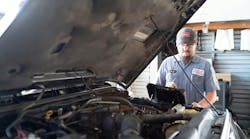More and more fleets using telematics are switching over to usage-based insurance (UBI).
“Usage-based insurance uses technology, commonly telematics, to track mileage and driver behavior,” says Jenny Shiner, communication manager for GPS Insight. “By installing telematics devices into commercial vehicles, it allows an auto insurer to understand individual driver behavior so that they can offer premium rates based on low-risk drivers.”
When it comes to fleets, insurers are looking for a couple of things in the telematics data. One, if the drivers are less likely to get into accidents, and two, if the behaviors of the drivers will lessen the severity of any accidents that do happen.
“This information is commonly gathered through driver behavior events, such as speeding, harsh braking, and cornering, [which] indicate a high- or low-risk driver,” Shiner says.
Insurance companies don’t want to cover anyone that poses as too much of a liability the same way fleets don’t want drivers that will hike up their insurance rates. In order to encourage safe driving, many fleets use the data from their telematics systems to create incentive programs rewarding those with good driving behaviors.
“The data [also] offers insight into driver behavior that allows coaching on safer practices. Many fleets put a policy in place around the technology to help hold drivers accountable,” Shiner says.
Practicing good driving behaviors, in combination with adopting UBI, is a win for fleets overall. With UBI, fleet owners have the opportunity to greatly reduce their insurance costs. By having telematics in place, it not only encourages safe driving but can also show the insurers the fleet is a safe investment.
To save money and lower insurance rates, fleets must use their telematics data proactively to improve driver behavior.
“Fleets should be aware that merely installing the telematics devices is not enough; they need to ensure they are coaching their drivers with the information,” Shiner says. “The data must display their drivers are low risk, so coaching is an essential piece that needs to take place to maximize their savings.”
Telematics is crucial for managing and maintaining fleets, and now, with UBI, fleets have the opportunity to be rewarded for the data they are presenting to their insurance company.


